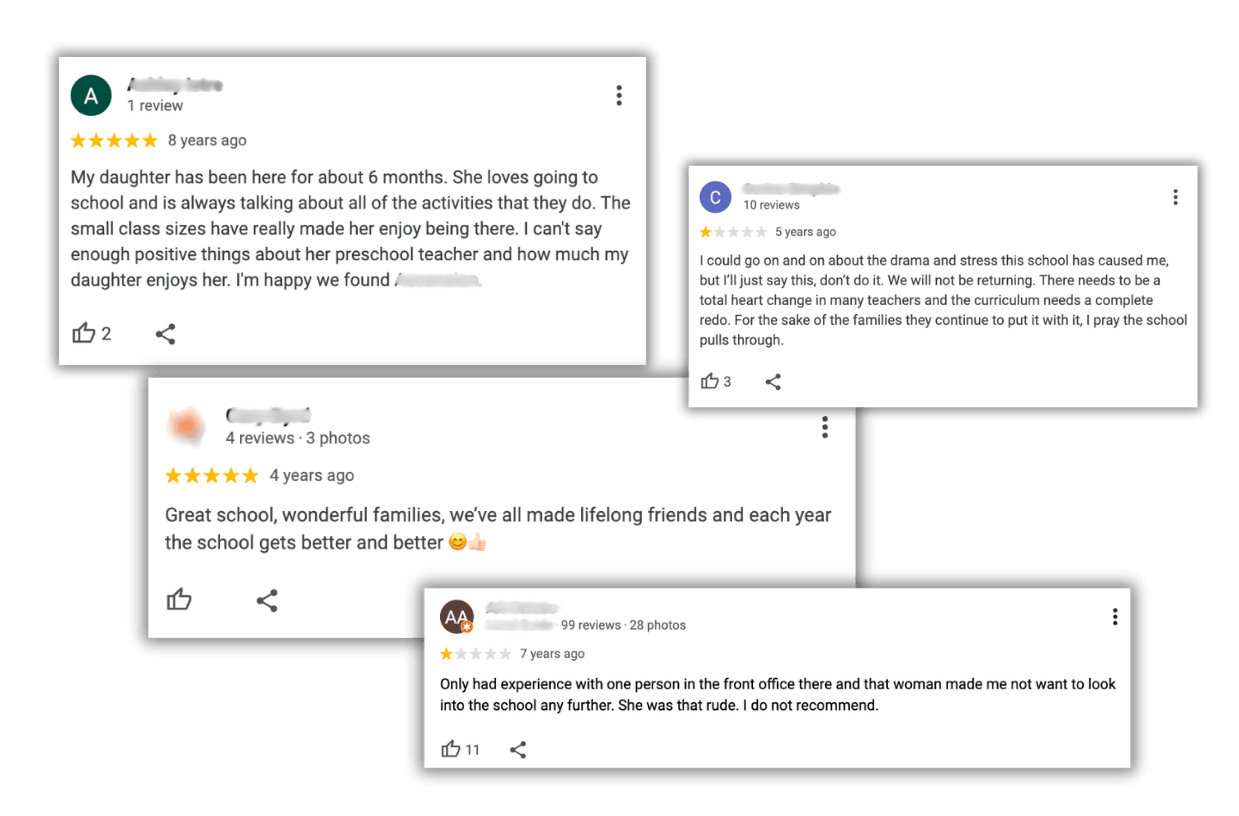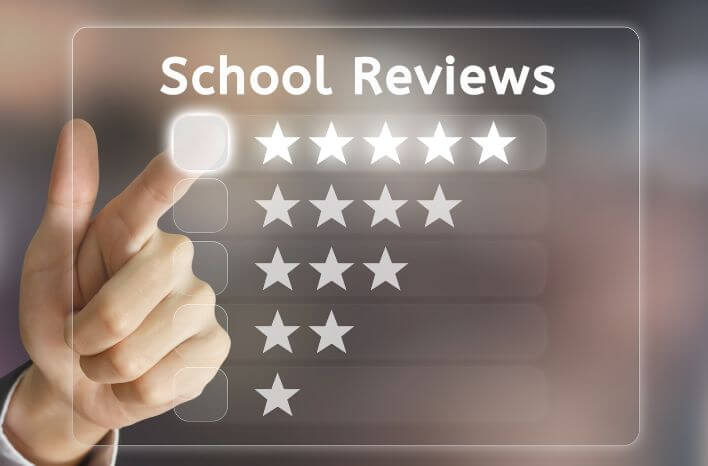For private and independent schools, reviews are more than just feedback. Reviews are a gateway to building trust and attracting prospective families to your school. As impactful as they are, reviews are not always the easiest to achieve. There’s no way around it: people are busy!
We’ve found that schools have the best results when asking at the ‘right time’ coupled with making the process as easy as possible. Here’s how to effectively gather reviews and create a foundation of credibility for your school.
Why do Schools Need Reviews?
Schools already have so many things telling their story: websites, social media, magazines, admissions events, and so on. But reviews support and reinforce it all!
When evaluating school options, parents are looking for the right fit: academically, socially, athletically, religiously, and a series of other “important” factors. At the root of their research, they want to know whether or not their child and family will thrive or have a lackluster experience. Not every family’s “thrive” or “lackluster” looks the same, so other experiences and perspectives come into play.
Of course, the school-produced collateral will tell the highlights, the best, and the brightest of the school experience. Prospective parents and guardians look to reviews for the lived version of the school story. Does it all align? Is there proof in the pudding?
Online reviews from current students, staff, alumni, and parents can provide that reassurance, confirming that a school is a trusted environment. For schools in the US, a thoughtful strategy to gather and highlight reviews is essential to maintaining a strong digital presence, especially as traditional word-of-mouth increasingly shifts to the online realm.
Google’s Stance on School Reviews
In 2019, Google restricted schools from getting reviews on Google My Business (GMB), categorizing them as “critical services” and, on April 30, 2025, they will delete all reviews from the preceding years.
There are pros and cons to this move by Google. On one hand, schools with negative reviews from 2018 likely celebrated the news that first impressions were no longer hinging on something they (hopefully) addressed and rectified. A program or teacher a parent was upset about in 2015 may no longer be at the school, yet those reviews were there for all to see. On the flip side, some feel this limits transparency and breaks trust since 94% of school searchers end up on Google at some point in their search journey.

As of now, schools can still utilize the Google My Business “post” feature to keep profiles updated with events and news, keeping their online presence vibrant without direct reviews. Without Google reviews, schools have strategically turned to various sites to bolster their social proof (more on those later).
How to Get Reviews: Practical Strategies
1. Create Engaging Flyers with QR Codes
Make it easy for parents to leave reviews by setting up branded flyers with QR codes that link directly to review platforms. Place these in high-traffic areas—like lobbies, welcome desks, and event spaces—and hand them out at major school events. This effortless access can encourage more parents to share their positive experiences.
2. Leverage School Newsletters
Your school newsletter reaches parents who are likely already engaged and invested in the school. Periodically include a reminder and a link encouraging families to leave a review.
3. Capitalize on Warm, Fuzzy Feelings
The easiest place to start is with your volunteer Parent Ambassadors. These parents are likely engrained and invested in your school, looking for ways to help. Ask them to rotate through your desired review websites over the course of the year. In the spring, just before your terminal grade’s graduation, ask departing families to reflect on their experience. At this point, they’re likely feeling the most satisfied and reflective about their child’s journey—so they should have plenty of positive feedback to share!
4. Diversify Your Reviewers: Ask Faculty, Alumni, and Parents
While parents are the primary group to ask for reviews, don’t overlook current students, faculty, alumni, and even board members. Their insights add diversity and depth to your reviews, making them more comprehensive and representative of the school community.
It’s more effective to invite people personally, or at the very least, in a segmented email group.
Where to Get Reviews
Here are some of the top platforms for reviews, along with tips for each:
- GreatSchools.org: This trusted site provides ratings for private, public, and charter schools. Encourage families to leave reviews on GreatSchools by including links in emails, newsletters, and on your website.
- Niche.com: Known for detailed profiles, Niche also ranks schools by multiple factors. Regularly share your Niche profile on social media, encouraging current parents to leave feedback.
- PrivateSchoolReview.com: This platform focuses specifically on private institutions. Encourage alumni and current families to share their experiences here, especially if they’re invested in your school’s success.
- Winnie.com: Ideal for preschools and schools offering early childhood programs, Winnie connects parents to reviews of local options. Mention Winnie when talking to parents in these programs, especially if you’ve received positive feedback from them directly.
- BoardingSchoolReview.com: If your school includes a boarding program, this platform is an essential place for reviews. Reach out to boarding families, as well as alumni who may have fond memories of their boarding experiences, and encourage them to share their stories here.
- SchoolDigger.com: SchoolDigger provides detailed profiles of over 136,000 public and private schools across the US, including test scores, enrollment data, and rankings. Share your SchoolDigger profile with families and encourage them to leave reviews, helping future parents make informed decisions about your school.
- Local Directories: Check local directories and parenting blogs for school review options. Claim your listings, update any missing information, and ensure all details are correct so parents feel encouraged to share their experiences.
- Social Media: Facebook is still a worthwhile place to capture reviews. It may have a different clout than it once did, but people still check out businesses on the platform.
What to Do Once You Have Reviews?
Great job! You’ve got new, fresh reviews.
- Grab your favorite ones and pull them to your website as text (not an image/graphic).
- Use them in your social content and PPC ads.
- Incorporate them into your email nurture campaign.
Adding a “testimonials” section to your website, e-mails, and social media feed reinforces, builds trust, and brings in different voices to tell your school’s story. With 88% of consumers trusting online reviews as much as personal recommendations and 72% saying positive reviews and testimonials made them trust a business more, investing in reviews is worthwhile in more ways than one.
Final Thoughts: Build a Digital Word-of-Mouth Strategy
While traditional word-of-mouth is still powerful, schools must prioritize their digital word-of-mouth to support their digital footprint. This caters to searching families plus the AI chatbots/LLMs (Large Language Models) that scrape the internet to determine school rankings for their results. Aim to diversify reviews by asking current students, parents, faculty, and alumni. In the ask, make it as effortless as possible by linking to the ideal site(s) and providing helpful instructions. With the right approach, your school’s online presence can be a powerful resource for prospective families.

Moira Anderson is the Assistant Production Manager at Truth Tree, where she collaborates closely with the Director of Technology & Innovation to develop and implement comprehensive digital marketing strategies that drive results. Her expertise in project management ensures smooth execution of initiatives, while her passion for connecting schools with their audiences helps tell each institution’s unique story effectively.
Ready to Take Your Marketing to the Next Level?
Truth Tree provides digital marketing strategies and solutions for schools looking to elevate their digital visibility with searching families.
Reach out to see what our two teams could dream up for you and your school











